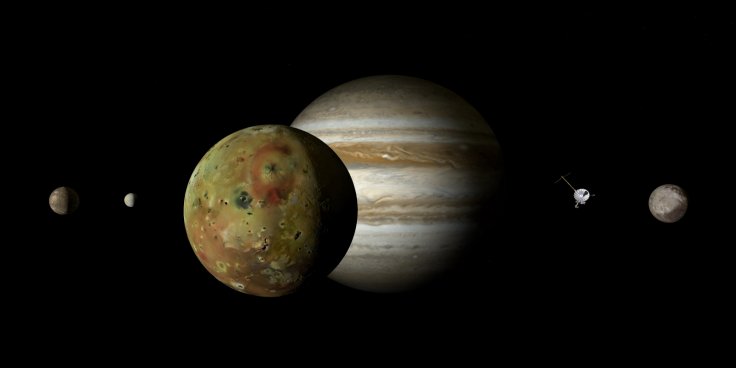The beautiful ice-crusted moon Europa is one of the numerous natural satellites that orbit the planetary giant, Jupiter. However, unlike its nearly 80 or so fellow moons, there is something special about Europa—it glows in the dark. According to scientists from NASA, the constant bombardment by Jupiter's high-energy radiations may give the moon its otherworldly glow in the absence of light.
In a first of its kind study, scientists from NASA's Jet Propulsion Laboratory demonstrated what Europa's glow may appear like, and expounded the potential revelation it could lead to about the ice on the moon's surface and about its composition. To the naked eye, this glow could appear as either slightly blue or green, or even white, depending on the degree of brightness and the materials it interacts with on the surface.

"We were able to predict that this nightside ice glow could provide additional information on Europa's surface composition. How that composition varies could give us clues about whether Europa harbors conditions suitable for life," said Murthy Gudipati, lead author of the study, in a statement.
A Celestial Consort
Named after one of the lovers of the Greek god Zeus, Europa is one of the 79 known moons—excluding other moonlets—of the giant planet. It is also part of a group of four moons known as 'Galilean Moons' Through earlier observations, scientists have concluded that the moon's surface could be composed of a mixture of ice and other commonly found salts on Earth, such as sodium chloride (table salt) and magnesium sulfate (Epsom salt).

It is also believed that Europa harbors an enormous interior ocean that could make its way through the thick ice crust and on to the surface. Therefore, analysis of the surface may help scientists understand what may lie beneath the icy surface. The glimmer emitted by the moon could be varied depending on the different salt compounds that Jupiter's radiations interact with.
Usually, researchers rely on a spectrometer to segregate light into various wavelengths and link the unique spectra or "signatures" to the varied compositions of the ice. Also, it is no surprise that an irradiated surface glows. When the energy-laded electrons penetrate through the surface, the molecules underneath are energized. Upon relaxing, the molecules release energy in the form of visible light. Thus, the new research incorporated the idea that the introduction of salts into watery ice under conditions similar to Europa, and irradiating it, could produce a glow.
Simulating Europa's Surface
In order to study the simulated surface of Europa, the researchers constructed a special device known as Ice Chamber for Europa's High-Energy Electron and Radiation Environment Testing (ICE-HEART). They commenced experiments with the focus being something entirely different: to ascertain how organic material found under Europa's surface may react to massive bursts of radiation.

However, the connection between variations in the glow produced and different ice compositions was beyond what the authors had expected. "But we never imagined that we would see what we ended up seeing. When we tried new ice compositions, the glow looked different. And we all just stared at it for a while and then said, 'This is new, right? This is definitely a different glow?' So we pointed a spectrometer at it, and each type of ice had a different spectrum," explained Bryana Henderson, co-author of the study.
A Moon Like No Other
Normally, a moon is visible in a dark sky because of its ability to reflect the sun's light. This is far from unusual and is observable in action through Earth's moon—Our Moon. However, the glow produced by Europa is based on a completely different process, the scientists highlighted. The study, thus, offers the peculiar possibility of a moon that continuously glows even on the side that faces away from the sun—its dark side or nightside.
"If Europa weren't under this radiation, it would look the way our moon looks to us – dark on the shadowed side. But because it's bombarded by the radiation from Jupiter, it glows in the dark," explained Gudipati. The findings of the study may help in making upcoming missions such as the Europa Clipper more effective.
Potential to Help Europa Missions

Upon being launched, Europa Clipper—while orbiting Jupiter—will conduct several flybys in order to observe Europa's surface. In fact, mission scientists have already begun examining the findings of the study in order to analyze if such a glow could be detected on the moon using the scientific instruments that the spacecraft will be equipped with.
"It's not often that you're in a lab and say, 'We might find this when we get there.' Usually it's the other way around – you go there and find something and try to explain it in the lab. But our prediction goes back to a simple observation, and that's what science is about," averred Gudipati.
It is likely that when the spacecraft gathers data about the surface of Europa, it could match the findings of the current study. And it could potentially help in the identification of the salt molecule found on the surface of the moon. While Europa Clipper is not a life finding mission, it could certainly help if Europa has the potential to support life. It may also provide insights into the very development of life on earth and the chance of finding life on other planets.









